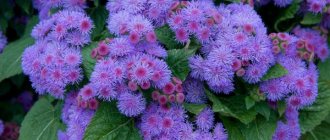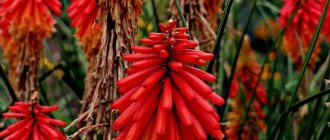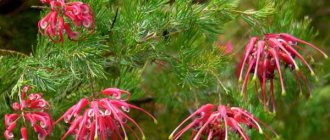Author: Elena N. https://floristics.info/ru/index.php?option=com_contact&view=contact&id=19 Category: Garden plants Published: February 09, 2019Last edits: January 20, 2021
- When to plant
- Growing conditions
- How and when to collect seeds
- Clarkia graceful, or marigold (Clarkia unguiculata = Clarkia elegans)
Clarkia is a charming flowering annual, an elegant and beautiful plant, closely related to godetia. Clarkia seeds germinate well, seedlings grow very quickly, and flowering lasts about three months. Clarkia is represented by many species and varieties of different colors, including those with double flowers, which are located on the peduncles so densely that the leaves are almost invisible because of them.
Our article contains information about:
- what varieties of clarkia are the most popular;
- how to sow clarkia seedlings;
- when and how to transplant seedlings into a flower garden;
- how to care for the plant during the season;
- how to collect clarkia seeds.
Planting and caring for clarkia
- Planting: sowing seeds in the ground - in April or early May, you can, but sow them before winter; sowing seeds for seedlings - in March, transplanting seedlings into the ground - in the second or third ten days of May.
- Lighting: bright sunlight.
- Soil: loose, light, dry, fertile, slightly acidic soil. Oily soil is not suitable for the plant.
- Watering: only during drought - twice a week.
- Feeding: during the periods of budding and flowering, once every two weeks with complex mineral fertilizer.
- Reproduction: seed.
- Pests: mealybugs, garden flea beetles.
- Diseases: rust.
Read more about growing clarkia below.
flowers (lat. Clarkia) are a genus of annual herbs of the fireweed family, close to Godetia, which some botanists combine with Clarkia into one genus. The plant is named after the captain named William Clark who brought it from California to Europe in the 19th century. In nature, the clarkia flower grows in the west of North America and Chile and has more than 30 species, of which only three are of interest to gardeners.
Features of cleome
Cleome has a very powerful root system. Branched strong shoots, on their surface there is pubescence consisting of short glandular hairs. The height of the bush can reach up to 150 cm. The greenish alternate leaf plates of some species have small spines on the underside. Leaves can be simple or complex: they consist of 5 or 7 entire elongated linear leaflets. The apical leaf blades are small and entire. The apical racemose inflorescences consist of flowers that have a regular shape and are purple, pink, white or yellow in color. The flowers have relatively long stamens that look like spider legs. The fruit is a unilocular polysperm, pod-shaped, and can reach about 30 mm in length. Most amateur gardeners do not like the floral smell of cleome, but in an outdoor garden it is completely impossible to smell it, but it can repel pests. This unusual aroma is necessary for such a flower to attract small bats in the wild, which are its pollinators.
Flowers bloom beautifully for the garden. Cleome from seed to flowering!
Watch this video on YouTube
Botanical description
So, the clarkia plant is an annual herbaceous crop, reaching a height of 30 to 90 cm. The stems of clarkia are branched, erect, usually pubescent with short villi. Elongated oval sessile leaves of bright green or bluish color are arranged alternately. Simple or double axillary flowers of regular shape with a diameter of up to 3.5 cm, painted in different colors, usually collected in spike-shaped or racemose apical inflorescences, but occasionally a single arrangement of flowers is found. The calyx of the flower is tubular, the corolla consists of four whole or three-lobed flowers, which taper at the base into a marigold. The fruit of clarkia is an elongated polysperm.
- When to sow petunia for seedlings, or how to get seedlings ready for planting in 75 days
How is it different from godetia?
Clarkia is very similar to godetia, the similarity is so strong that some botanists even considered these crops to be a variety of the same plant for a long time. However, these are different cultures.
Claricia's flowers are small, looking like miniature roses, as if strung on twig stems. Godetia's flowers are quite large, elegant, satiny - each size is 6-8 cm, they can be double or simple. Both cultures can have a wide variety of shades: white, pink, as well as scarlet, purple, lilac and bluish.
The height of the bush also varies. Clarkia grows up to 30–90 cm, while the length of the Godetia stem does not exceed 30–40 cm.
Despite their differences, gardeners often plant these plants together. They claim that the cultures harmoniously complement each other in the flowerbed.
Growing clarkia from seeds
How to sow seeds
Clarkia flowers are grown by seed - seedlings or non-seedlings. With the seedless method, clarkia seeds are sown directly into the ground. This can be done in April or early May, as well as in late autumn, before winter. Before sowing clarkia, add 1 kg of peat per m² and a tablespoon of potassium sulfate with superphosphate to the area to be dug, and a tablespoon of each for the same area. You need to dig up the area with fertilizers at least two weeks before sowing.
Small clarkia seeds are sown in nests of 4-5 pieces at a distance of 20-40 cm, but are not buried in the ground, but lightly pressed onto it and sprinkled with the thinnest layer of soil. Shoots may appear in as little as two weeks, and you will have to thin them out, but don’t get carried away—clarkia blooming in a dense bush looks more beautiful. When planted in autumn, the seedlings have time to germinate before the onset of winter and are preserved well under the snow, but even if the crops do not germinate, there is nothing to worry about. In the spring, when Clarkia sprouts, you only need to thin it out, like carrots.
Seedling care
Clarkia from seeds, grown by seedlings, at the very beginning of its life is reliably protected from temperature changes, frosts, cold spring rains and other seasonal and climatic troubles, which is why many flower lovers prefer to grow seedlings rather than sow flowers directly into the ground. Clarkia seeds are sown for seedlings in March, then it will bloom in early June.
Sow the seeds in slightly acidic soil, press them down with a board, sprinkle them with water, cover with glass and place in a bright, warm place out of direct sunlight. As soon as the shoots appear, the glass can be removed, but the container with the crops should remain in a dry, warm place with good ventilation until planting in open ground. Clarkia should be picked as early as possible - as soon as the seedlings have their first leaves.
How to grow properly
Cold stratification brings good results. For proper cultivation you need:
- Treat the seeds with a solution of potassium permanganate or fungicide before sowing.
- Place on the surface of the soil and press slightly into the surface. Since the seeds are small, they can be mixed with sand 1 to 10.
- Moisten the soil with a spray bottle and cover the container with film or glass.
Seedlings need to be picked after the first leaves appear on the tenth day from sowing. Before planting in open ground, young plants are kept in a greenhouse or planted directly into the ground at the end of April or May.
When growing clarkia in seedlings, it is important to choose the right soil mixture. This plant prefers the following soil composition: humus, river sand, peat, leaf soil. Ratio: 1:1:1:2. It would not be superfluous to disinfect the soil with a slightly pink solution of potassium permanganate.
To ensure the stability of the shoots, you can install a peg in the center of the group and tie up young plants. For stems that have reached a height of 12 cm, pinch the top to form a crown.
Planting clarkia in open ground
When to plant
Clarkia flowers are planted in open ground in May. If the soil on your site is not suitable for clarkia due to its pH value, there are several ways to acidify it: add one to one and a half kilograms of peat or 60 g of sulfur per square meter to the soil for digging, or spill the soil with a solution of oxalic or citric acid at the rate 1.5 tablespoons per 10 liters of water. If the soil is too acidic, it is limed before planting the clarkia, and if it is too oily, the area is dug up with sand. Well, don’t forget to add fertilizers, which have already been mentioned. You need to prepare the area for Clarkia at least two weeks before planting.
How to plant
Clarkia is planted in this way: seedlings are taken out of the container not one at a time, but in groups, together with a lump of earth, and also planted in holes located at a distance of 20 to 40 cm from each other. Near each hole you need to stick a stick or a rod, which will serve as a support for the thin stems of the clarkia when the bushes grow. Plant different varieties of plants at a distance from each other, because they can cross-pollinate with each other. After planting, the plants are watered and lightly pinched to stimulate tillering.
- Spirea pruning
Care requirements
Like any, even the most unpretentious crop, Clarkia requires attention. Care consists of the usual procedures of watering, weeding, loosening and fertilizing.
The guideline for watering is the condition of the soil - you need to water when the soil dries out. The flower reacts equally poorly to excess moisture and excessive drying of the soil. The volume of watering should be moderate so that the water does not stand under the bushes, but is evenly absorbed. Several times a season, the soil is loosened after watering to remove crust.
Organic fertilizers are not advisable for Clarkia. Mineral complexes are more preferable - they provide the bush with the necessary nutrition and promote long-term flowering. They need to be applied according to the instructions 3-4 times during the summer.
A flower bed looks sloppy if you do not remove dried leaves and buds, so regular plucking of drying foliage and wilted buds will ensure that the bushes are decorative. In addition, this procedure will prevent the spread of infections and pests. If you want to prepare the seeds yourself, you can leave a few buds by pinching the top of the stem for quick ripening. If you leave all the buds, then during self-seeding the plantings become thicker, which ultimately affects the decorative effect.
Clarkia care
Growing conditions
Growing clarkia and caring for it will not require any special knowledge or effort from you. The plant only needs to be watered twice a week during dry periods, and the rest of the time, rain moisture will suffice for Clarkia. For irrigation, you need enough water so that it is quickly absorbed and does not stand in a puddle around the plant.
During the periods of budding and flowering, Clarkia is fed with complex mineral fertilizers once every two weeks. Kemira or Rainbow are suitable for this purpose; Clarkia is not fertilized with organic matter. Remove faded flowers and seed pods so that the plant spends its energy only on the formation of new buds. That's all there is to caring for Clarkia.
Pests and diseases
Of the insect pests, clarkia is affected by the mealybug, traces of whose vital activity look like a cotton wool-like waxy coating on the ground parts of plants. Mealybugs are combated by spraying with Aktara, Confidor or Fitoverm.
If the soil in the area with clarkia is loamy, this may cause a fungal disease, manifested by rusty-yellow spots with a brown border on the leaves. To destroy the fungus, the plant is sprayed with fungicides - Bordeaux mixture or oxychome, for example. In general, Clarkia is a very resistant plant to pests and diseases, and if you properly prepare the soil for it, neither it nor you will have problems with it.
Diseases and pests: treatment
Clarkia is a fairly resistant plant and impervious to diseases and pests, however, due to errors in maintenance and care, the plant may become ill or be attacked by insect pests.
Growing a bush on loamy soils can cause rust disease. This fungal disease appears as reddish-yellow spots with a clear dark border on the leaf blades. In most cases, the disease occurs due to waterlogging of the soil and stagnation of water, as well as excess nitrogen-containing fertilizers. To treat the bush, spray with fungicides (Bordeaux mixture, Topaz) 2 times a week.
If there is excess moisture, the roots of the plant can rot, as a result of which the plant weakens, withers and dies. At an early stage of the disease, the bush can be saved. To do this, drooping, weakened, affected parts of the plant are cut off and treated with fungicides. Also, high soil moisture can provoke the appearance of downy mildew: colorless or dark spots appear on the back side of the affected leaf blade. Leaves curl and become deformed. For control, the biofungicide “Fitosporin-M” or “Olirna” is used.
Of the insect pests, the mealybug is dangerous; aphids rarely settle on the plant. To get rid of the scourge, insecticides are used; spraying the peels of citrus fruits or garlic with an infusion helps against aphids. You need to be extremely careful with the latter, as it can leave burns on the plant. If treatment and prevention do not save the plant, then it is dug up with all its infected parts and destroyed by burning.
How to get rid of flower midge?
In most cases, an indicator of excessive soil waterlogging is the appearance of flower midge or sciarid. Most often their appearance occurs in winter.
The danger is not from the midges themselves, but from their larvae, which can damage the roots of the plant. When there are so many larvae that they are visible, the plants are transplanted to another place that has been treated against flower midges.
To prevent the proliferation of flower midges, you should periodically loosen the soil around the flower; before planting, you should create a drainage layer, avoid stagnation and excessive waterlogging of the soil. Damaged and diseased parts of the bush should be removed immediately.
They fight flower midges in various ways. The simplest one, which is most suitable for potted flowers: insert 4-8 matches into the ground around the flower with a sulfur coating, as soon as the sulfur dissolves, repeat the procedure 2-4 times.
Watering with a weak (pale pink) solution of potassium permanganate or a weak soap solution also helps get rid of midges well.
Garlic infusion allows you to reduce and completely remove unwanted insects. It is prepared as follows: add 3-4 chopped garlic cloves to 1 liter of boiling water, leave for at least 4 hours, filter and spray the plants. However, this solution can burn leaves and flowers. For those who are afraid of harming the plant, you can use garlic in another way: cut the garlic cloves and place them on the ground, cut side down, around the trunk of the plant.
An orange peel stuck and spread on the ground around a flower can also protect clarkia from midges.
They also use a chemical insect repellent pencil (for example, “Mashenka”), grind it and sprinkle it with soil.
Insecticides “Bazudin”, “Grom-2” and “Fly-eater” can quickly cope with insect attacks on a flower.
Clarkia after flowering
How and when to collect seeds
Actually, Clarkia reproduces well by self-sowing; you just need to carefully thin it out in the spring, when the bristles of Clarkia seedlings appear. But if you still decide to collect the seeds, then doing it couldn’t be easier: select several beautiful flowers during flowering and, when they begin to fade, tie them with gauze so that the seeds, when ripe, do not fall to the ground. The seeds ripen a month after the end of flowering, when the capsule turns brown. Cut off the seed pod, sprinkle it on newspaper, dry it and sow it before winter or store it in a paper bag until spring.
Clarkia in winter
After the clarkia has finished blooming, it can be cut back to the ground, and when it comes time to dig up the area, remove the remains of the clarkia and destroy them. It is best to burn them to prevent the development of pathogenic bacteria and fungi in them, which can infect the soil or healthy plants.
Problems in growing
Clarkia graceful is a hardy plant. However, the following can spoil the appearance and even lead to the death of the plant:
- fungal diseases;
- pest invasion;
- violations of agricultural technology.
A fungal disease is indicated by gray spots with a pronounced dark edge. They appear on flowers and leaves. The affected parts of the plant are immediately removed and destroyed. Tissues without signs of damage are treated with a fungicide.
If small insects with a white coating are noticed on the plant, it is a mealybug. The parasite greatly weakens the clarkia by feeding on its cell sap, so measures must be taken immediately. The drug Rogor-S will help cope with mealybugs.
Young plants are attacked by psyllids. They chew out parts of the leaf and can quickly destroy plants. To prevent attacks by these insects, the seedlings are covered with non-woven fabric. Already affected specimens are treated with actara.
For your information! A well-chosen place for growth contributes to the active development of clarkia. The absence of stagnant moisture will protect the root system from rotting.
In general, clarkia graceful is a good choice for creating annual flower beds or to complement perennial compositions. The plant is undemanding and has a long flowering period. In flower beds it is successfully combined with asters, daisies, and phlox.
Types and varieties
As already mentioned, only three types of clarkia are grown in garden culture: clarkia marigold, or clarkia graceful; pretty clarkia, or pubescent clarkia; Clarkia Brevery.
- Autumn pruning of ornamental shrubs
Clarkia graceful, or marigold (Clarkia unguiculata = Clarkia elegans)
The Clarkia graceful flower grows wild in California. It is a branched, dense annual up to a meter high. Its stems are strong, thin, woody in the lower part, the leaves are oval, bluish-green with red veins, unevenly sparsely toothed along the edges. Regular flowers up to 4 cm in diameter, simple or double, white, red, purple, pink or blue, are located one at a time in the leaf axils. Small seeds remain viable for up to 4 years. Blooms profusely from July to September. Growing Clarkia elegans is very common in our climate. Popular varieties:
- Albatross - terry clarkia white, the height of the branched bush is about 75 cm;
- Purpurkenig - a double variety of carmine color, flowers with a diameter of 3.5-4 cm, bush height 80-90 cm;
- Salmon perfection - double, salmon-pink flowers up to 3.5 cm in diameter, loose bush up to 90 cm high.
Clarkia pulchella
The plant is dwarf. Its stems are branched, erect, up to 40 cm tall. The leaves are green, long, narrow, entire, pointed towards the apex and tapered towards the petiole. The flowers are simple or double, solitary or collected in several pieces in the axils of the leaves on the tops of the shoots. The shape of the petals, divided into three widely spaced lobes, is original, which is why the Americans nicknamed this species “moose horns.” It blooms two weeks earlier than the graceful clarkia.
Clarkia breweri
For some time now, the species Clarkia Breveri has been gaining popularity - a cold-resistant annual up to 50 cm high. The butterfly-like flowers, up to 3 cm in diameter, forming loose inflorescences, have a strong and pleasant aroma. Varieties:
- Pink Ribbons is a variety with pink flowers, the petals of which resemble ribbons, the height of the bush is only 30 cm, the stems are branched, the flowering is abundant.
All the other Clarkia species you've heard or read about are actually members of the genus Godetia.
Multi-colored mixtures of Clarkia
Clarkia "Double Mixed". Flowers combine all characteristics except color. These flowers are good to combine in flower beds and collect in bouquets.
Clarkia "Bouquet Mixed". The photo will perfectly show the originality and beauty of the buds.
Clarkia color mix . Breeders created an amazing variety. On one bush you can see a mixture of different shades. What makes it especially original. It’s as if a bouquet has been assembled into a living composition.
Flowers are successfully planted individually or in group plantings. Clarkia, a graceful mixture of crimson, lilac and white-pink tones. The plant is classified as tall, reaching 0.9 meters. Flowers retain their pristine beauty for a long time when cut.
Clarkia terry. The flower is classified as a medium-sized crop (0.25-0.65 m). Double inflorescences are 6 cm in diameter, located in the axils of the leaves, which are barely noticeable from under the buds.
It seems as if they are strung on stems in the form of an ear or a brush. Flower beds with double clarkia shimmer in different shades. The buds can be in white, purple, red, lilac, pink.
Clarkia pubescent . Miniature plant 30 cm long. The petals are deeply cut in the shape of tridents. In landscape design it goes well with tall plants, where it appears in the foreground with unusually beautiful buds of lilac tones.
Clarkia pubescent
Calculation of planting dates
For example, if you need to decorate a flower bed with buds for International Children's Day, celebrated on June 1, Clarkia seeds should be placed in a moist environment in the first weeks of spring. When using later varieties, sowing is done at the end of winter.
The seedlings are transferred to open ground after it has completely warmed up. This minimizes the risk of infecting the root system with harmful bacteria. The optimal time for such a transplant is the last weeks of spring. In southern latitudes, this procedure can be carried out already in the first half of May.
Preparing seeds for sowing
Climbing roses: planting, care, cultivation
First you need to purchase high-quality seed material from the store. It’s even better to collect the seeds yourself. The Clarkia seed pod has an oblong shape, the seeds are brown and small. Retain excellent germination for 4 years if storage conditions are met. To prevent possible infection of seeds by diseases, before planting, they should be soaked in a weak solution of potassium permanganate for 2-3 hours, first wrapped in gauze or other clean thin cloth. After this, they are laid out to dry on dry napkins or cloth. When the seeds are dry, you can start planting.
Collecting seeds
If faded inflorescences are not removed, seed pods form on them. Small seeds are formed in them. After complete ripening, the capsule opens and the seeds spontaneously spill out.
If a gardener is going to grow graceful clarkia seedlings on his own, then the selection of suitable inflorescences should be done during flowering. The most lush and beautiful buds should be noted, and when they wither, so that the seed material is not sown, tie them with cotton cloth. A month later, when the boxes are ready, they are cut off. The seeds are poured onto a sheet of white paper and dried. Store planting material in a paper envelope or box.











